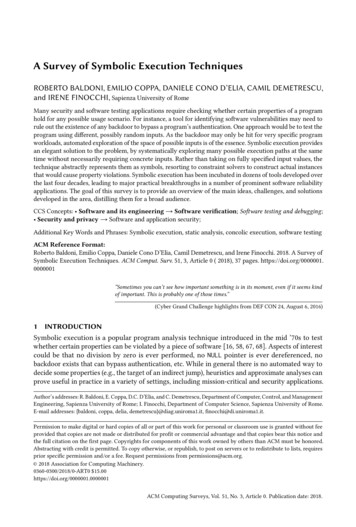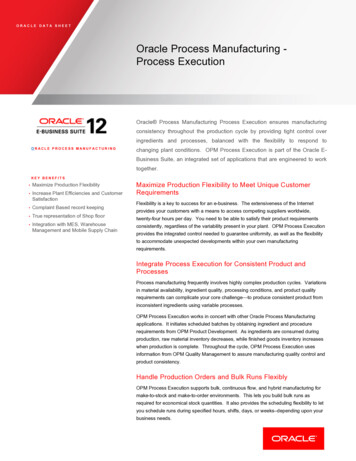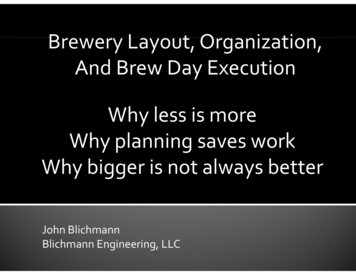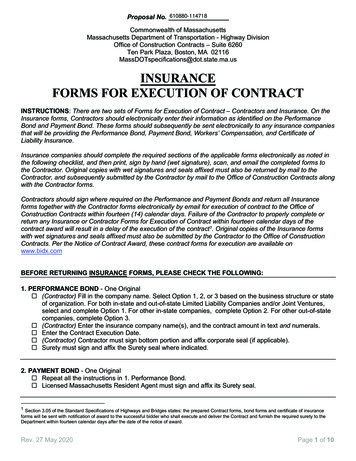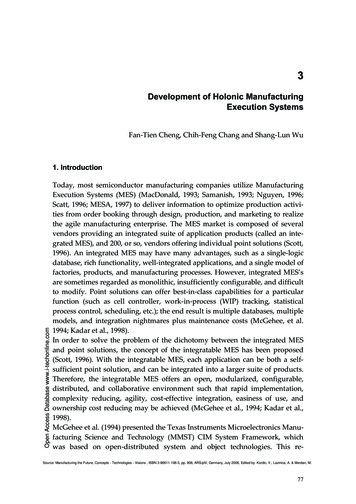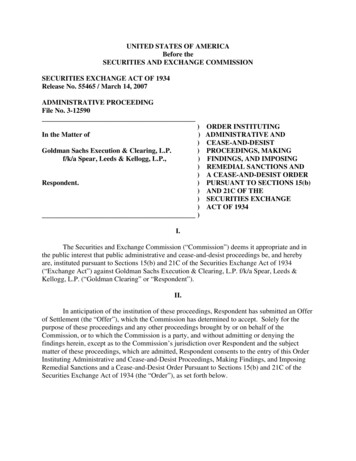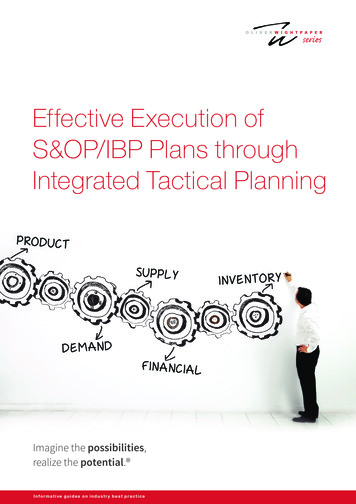
Transcription
Effective Execution ofS&OP/IBP Plans throughIntegrated Tactical PlanningInformative guides on industr y best practice
T H E O L I V E R W I G H T W H I T E PA P E R S E R I E SIntroductionMany companies that have embarked on an Integrated Business Planning implementationstill find senior managers being dragged into short-term tactical issues and problem-solving.Despite putting considerable effort and energy into executing their plans, many still strugglewith poor customer service, high costs, and high inventories. While Integrated BusinessPlanning is highly effective in aiding planning over a four to 24- or 36-month horizon right downto EBIT projections, it was never designed to control the execution of those plans within theone-to-three-month tactical horizon. This is the role of Integrated Tactical Planning. Unlessplans are properly managed and coordinated during this time period, execution is problematic.The constant last-minute changes and “firefighting” that plague the business also lead to highlevels of frustration.The importance of ensuring a process such as Integrated Tactical Planning exists isparticularly topical given the unnerving climate of uncertainty and the challenges facingmany organizations right now. The time frame in which decisions must be made has shiftedfrom years and months to weeks and days. This is where Integrated Tactical Planning –synchronized processes with clear responsibilities and expected outcomes – can help.The successful deployment of Integrated Tactical Planning will define and calm the process ofmanagement and communication in the execution window, creating the integration betweenthe various functions within the organization, and ultimately leading to improvements incustomer service, inventory levels, and other key metrics.2
T H E O L I V E R W I G H T W H I T E PA P E R S E R I E SWhen Should You Think About IntegratedTactical Planning?Table 1: Symptoms of Non-Integrated ProcessesAs the table above illustrates, there are many symptoms of a failing planning process and it is acommon misconception that deploying S&OP (or more likely, its latter-day incarnation, IntegratedBusiness Planning), will fix these issues. Integrated Business Planning is a powerful decision-makingprocess that sits at the heart of the Oliver Wight Integrated Business Model (Figure 1) and is themeans many organizations now choose to run their entire business. However, as the Model shows,Integrated Business Planning cannot work in isolation; it needs to be supported by equally effectivemonthly (re-) planning, and weekly and daily execution processes. Thus, the Integrated BusinessModel is a deliberately designed, and all-encompassing set of processes, which integrates the annualbusiness planning cycle with the daily execution of plans, ensuring everybody within the organizationis aligned with a single game plan in support of the overall business strategy.Many organizations mistakenly find themselves deploying a monthly Integrated Business Planningprocess, which is meant to create plans and give the Executive visibility over 24 to 36 months, butwithout paying attention to how those plans are to be executed, compromising the intent of IntegratedBusiness Planning. Typically, they try to use the Integrated Business Planning process to manageboth the longer-term planning horizon and shorter-term execution horizon. Another common error issetting up a weekly Integrated Business Planning process, which by definition is not IntegratedBusiness Planning at all.3
T H E O L I V E R W I G H T W H I T E PA P E R S E R I E SWithout Integrated Tactical Planning within the short-term planning and execution window, it isinevitable senior managers will be drawn into spending their time on day-to-day problem-solving,rather than longer-term decision-making.Integrated Tactical Planning is part of the “below-the-line” processes within the Integrated BusinessModel (Figure 1). The objective of an Integrated Tactical Planning process is to take control of thesigned-off Integrated Business Planning plans and ensure they are being deployed at a weekly anddaily level. Any significant changes are then formally managed to continually re-optimize plans in theshort term or communicate otherwise. Most companies do some of this but tend to overly rely ongood people, rather than well-designed processes and formally defined ways of working. The intent ofIntegrated Tactical Planning is to focus on cost-effective management of change and deploying theIntegrated Business Planning plans.Figure 1: Integrated Business y ly SalesManagementProcurement Management“It is useful to think of Integrated Tactical Planning as the cogs in a gearbox - it doesn’t matter how big orsmall those cogs are if one is broken, the car stops. Each cog relies on the next, but a clutch is requiredto separate them and change gear to speed up, climb hills, slow down, or prepare for tight cornering. Todo this requires mechanisms to be designed into the gearbox in the first place, and not force-fittedafterward.”4
T H E O L I V E R W I G H T W H I T E PA P E R S E R I E SMany companies are usually doing some of this, but usually not bringing it all together. The intent is toalign, the more-detailed, below-the-line processes, back up to the aggregate monthly re-planningIntegrated Business Planning process, every week. It is specifically designed to keep seniormanagers “out of the weeds”, but, the temptation can be too great. Because all senior executiveshave come up through the ranks in at least one discipline, they can be very comfortable at that level ofdetail.ITP DefinitionIntegrated Tactical Planning is a crossfunctional, middle management processthat routinely re-aligns and re-optimizescore process plans (product, demand,and supply), and facilitates effectivecommunication, should re-alignment not bepossible. This is done weekly, typically overa 13-week horizon.It considers changes to the plans and, asrequired, escalates decisions to seniorlevels.A primary objective of the process is toensure execution of previously agreedIntegrated Business Planning process plans.ITP helps senior management to focuson the four-to-24-month horizon and in theprocess helps liberate the NCEPRODUCTMANAGEMENTREVIEWSUPPLYREVIEWSupply lioManagementSupply DetailPlanningSalesManagementProcurement Management"Integrated Tactical Panning (ITP) ensures alignment between the monthly plan, and what isdone day-to-day"5
T H E O L I V E R W I G H T W H I T E PA P E R S E R I E SFigure 2: Definition of Integrated Tactical PlanningThe Integrated Tactical Planning Time FrameThe time frame for Integrated Tactical Planning is usually referred to as the time fence or the planningtime fence. The most precise way of defining this planning time fence is when expenditure on variableand semi-variable expenses begins. For example, in a manufacturing or physical goods environment,the lead time for purchasing materials and products could be several months for items sourcedoverseas, or weeks, if they are sourced locally. But this is only one time fence the business might becommitted to. As shown in Figure 3, other time fences should also be considered: managingcustomer order expectations, contractual obligations, trade spend and promotional planning and newproduct introduction.All these are commitments to spend money on resources to deliver future demand requirementscompetitively and cost-effectively. Whereas the monthly Integrated Business Planning processmanages resources and supply to meet the demand plan, the key concept of the Integrated TacticalPlanning process does the opposite and manages demand to meet the available resource and supplyplans inside the planning time fence. This is because the closer you are to executing the plans the lessability you have to make changes, and the greater the cost of those changes and the chaos createdby change. Stability is critical.MANAGE DEMAND TOMATCH SUPPLYPLANNINGTIMEFENCEBALANCE MASTER SUPPLYPLAN TO MATCH DEMANDCUSTOMER ORDER TIME FENCEANNUAL CONTRACT TIME FENCENEW PRODUCT INTRODUCTION TIMEPROMOTION TIME FENCETIME6
T H E O L I V E R W I G H T W H I T E PA P E R S E R I E SFigure 3: Managing Time FencesManaging Business PlansThe core plans for Integrated Tactical Planning are the same core plans used in the IntegratedBusiness Planning process just at a lower level of detail such as by SKU and by hour/day/weekcompared to family/month. There are also "resultant plans", which are not discrete plans, but plansderived from and dependent on, the core plans e.g. financial outcomes and projections, and inventoryprojections.Product Portfolio PlanA key assumption is that before projects reach the Planning Time Fence, the entire portfolio isconsidered and there have been effectively managed project plans for each project, includingappropriate resources allocated. In so doing, the following factors are considered:1.Readiness for launch – products are in the final stage before launch and it is critical to ensureeverything is ready to go, from product availability and distribution, to sales team preparation,advertising, and public relations;2.Product Portfolio changes which are in the final stages of execution and will include executingthe phase-in and phase-out plans to minimize potential obsolescence and write-offs;3.Trials and product testing.Demand PlanThe demand plan is the anticipated product sales plan, out to the planning time fence. While it isoften said the demand plan, resulting from the Integrated Business Planning Demand Review, is anunconstrained statement of demand, once inside the planning time fence this is not the case as it isbalanced against available resources. As with the product plan, the demand plan is also pro-ratedinto weekly buckets and phased according to the weekly off-take pattern (see Figure 4 overleaf). Thisagreed demand plan then serves as a key input into resulting manufacturing and supplier schedules.Financial outcomes are derived from it, and it is one of the inputs in calculating inventory projections.Very few businesses have a perfect demand plan, so it is important that they can recognize changesand deviations from this plan to assess them for feasibility to avoid over-commitment of the availableresources.Supply PlanThe supply plan is the cost-effective response to what has been planned to be sold. These plans aresynchronized with the pro-rated weekly demand plan, out to the planning time fence, and in the nearterm, are likely to be reflected in daily or even hourly phasing. Once inside the planning time fence,flexibility with the supply plan is reduced because materials and goods have been ordered, shiftsand labor have been organized, and capacities and storage locations optimized. So, any changes tothe plans at this stage will cost money, e.g. items airfreighted at short notice, cut pallets distributed,or part loads transported.Financial and Inventory PlansOutcomes of product, demand and supply plans, are the financial and inventory plans. The crucialthing to note here is that these plans cannot be managed directly or discretely. They have a causeand-effect relationship with the preceding plans. While it is important to test changes against financialand inventory outcomes, the levers remain primarily in the product, demand and supply plans.7
T H E O L I V E R W I G H T W H I T E PA P E R S E R I E SFigure 4 shows an example of how plans are pro-rated and aligned with any recurring or identifiablephasing. The demand planning part of the Integrated Business Planning process identifies seasonalityor known one-off events, and the plans and numbers communicated that month, phased accordingly.Since these are in monthly buckets, they need to be pro-rated into weekly buckets reflecting thenormal off-take pattern. Often companies have really big first weeks of the month, or last weeks of themonth, because of terms of trade or promotional activity. Whatever the reason, requirements need tobe set up to match this pattern. In some industries, such as fresh milk, for example, a daily patternalso needs to be considered.The seasonality and weekly phasing assist with managing the "lumpiness", but as with managinglead-times it is important to plan for what is known in the first instance, and then work to remove thecauses of the lumpiness over time.Figure 4: Monthly, Weekly, Daily PhasingMonthly IntegratedBusinessPlanning(with seasonality)M1 M2 M3 M4 M5 M6 M7 M8 M9 6Weekly SupplyDemand-ProjectManagement(with weekly phasing)W1W2W3W4W5W6W7W8W9W10W11W12Daily Scheduling(with daily phasing)D18D2D3D4D5D6D7D8D9D10D11D12D13D14
T H E O L I V E R W I G H T W H I T E PA P E R S E R I E SManaging the Integrated Tactical Planning ProcessThe quorum managing Integrated Tactical Planning will vary from company to company, and by sizeand industry type, so this section uses generic roles. Each of the four major elements of planningexecution requires at least one formally defined role to identify and manage changes to plans insidethe planning time fence as follows:1.Managing changes to the Product Portfolio and supporting plans - Product Planning Manager2.Understanding demand and controlling demand-generation levers - Demand Execution Manager3.Understanding supply, and controlling supply and supplier capabilities and costs - SupplyPlanner/Scheduler4.Managing incoming orders and managing customer expectations - Customer Service/Or
S&OP/IBP Plans through Integrated Tactical Planning. THE OLIVER WIGHT WHITE PAPER SERIES 2 Introduction Many companies that have embarked on an Integrated Business Planning implementation still find senior managers being dragged into short-term tactical issues and problem-solving. Despite putting considerable effort and energy into executing their plans, many still struggle with poor customer .
